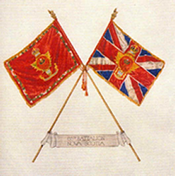Colours have not been carried in action since February 26, 1881, when a British Regiment carried them at Laing's Nek during the Boer War in South Africa. As they have no practical value, it may be thought that there is a case for their abolition, but Colours are the symbol of the spirit of the Regiment. On them are borne the battle honours and badges granted to the Regiment in commemoration of some of the gallant deeds performed by members of the Regiment from the time it was raised. This association of Colours with heroic deeds has caused them to be regarded with veneration. In a sense, they are an epitome of history of the Regiment. The full history of a regiment is contained in written words or records, but as these are not portable in convenient form, the Colours, emblazoned with distinctions for long and honorable service, are something in the nature of silken history, the sight of which instills a feeling of pride in soldiers and ex-soldiers.
The consecration of Colours is of very old origin, one of the earliest instances being that of the Pope consecrating the Standard of William the Conqueror at the Battle of Hastings.
Up to 1707, each company of a regiment carried a Colour, but in that year the number was reduced to three per battalion and between 1743 and 1751, the number of Colours was further reduced to two per battalion.
The distinction between the "King's colour" and the "Regimental Colour" did not arise until 1751, when a Royal Warrant of that year laid down that the "King's" or "First" Colour was to be the "Great Union" and the Regimental or Second Colour was to be the colour of the facings of the regiment, with a small unicorn in the upper canton, that is near the head of the pole.
The origin of the actual "Trooping the Colour" is the old ceremony of Sending for and Lodging the Colour and not, as is so often stated, the old Guard - Mounting Display at which the Colours are not normally "Trooped" down the ranks.
The Ensign then took the Colours to their lodgings and displayed them from their windows or entrance to their tent and the battalion or company trooped past the Colour and so came to know, in case of alarm, the place of their rallying point.
The custom of "Trooping the Colour" or Colours is now carried out only on special occasions. In London and many large garrisons, the Queen's Birthday is honored in this way --- the Queen's Colour of the "Duty Battalion" being trooped and guards being formed from all infantry units in the station. Many Regiments commemorate their principal Battle Honours by "Trooping" their "Regimental Colour" on the anniversary of the battle.
The 85th and 185th C.E.F. Colours |
The 85th and 185th C.E.F. received their colours from Lady Borden at Aldershot N.S. in 1915. The 2nd Bn N.S. Highlanders (Cape Breton) received their colours in Sydney N.S. in 1959. These colours were trooped during ceremonies in 1967. The colours are displayed in the Officer's Mess, Fort Oglvie Building, Victoria Park, Sydney. The 85th Bn C.E.F. W.W.I colours are in cased at the Public Archives Nova Scotia, Halifax N.S. |
| "A moth-eaten rag on a worm eaten pole, It does not look likely to stir a man's soul." 'Tis the deeds that were done ' neath the moth-eaten rag, When the pole was a staff, and the rag was a flag. |
News
Presentation Of New Colours
|
|
|
|---|---|---|

